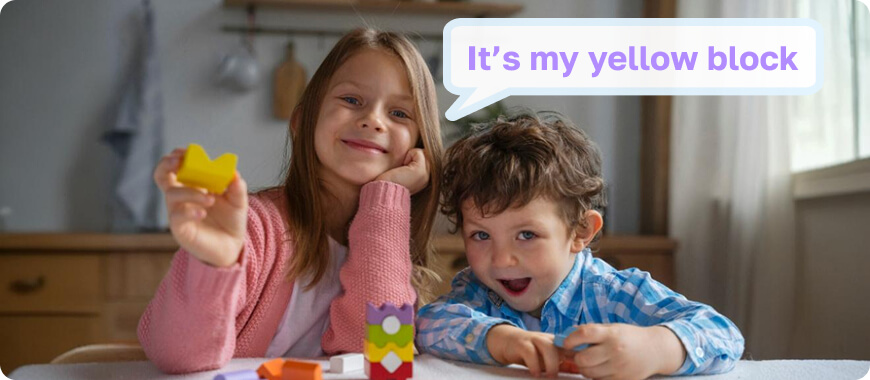If your child has ever said, “That’s my teddy!” or “Is this your pencil?”, they’re already using possessive adjectives—they just might not know it yet! But what’s the difference between “my” and “mine”? When do we say “his book” versus “the book is his”? And how can you help your child use possessive adjectives and pronouns correctly—without turning grammar into a chore?
In this guide, you’ll discover simple, playful, and highly effective ways to teach possessive adjectives for kids—from clear explanations to real-life practice ideas that actually stick.
Whether you’re a parent supporting learning at home or a teacher looking for fresh classroom strategies, you’ll walk away with tools to make English grammar feel natural, not intimidating. And yes—by the end, you’ll know exactly how to turn “That’s me book!” into “That’s my book!” with a smile.
What Are Possessive Adjectives and Pronouns?
At their core, possessive adjectives and possessive pronouns are all about showing who something belongs to. They help us talk about ownership or possession in a clear, polite way—essential for everyday English.
Possessive Adjectives: Showing Who Something Belongs To
Possessive adjectives always come before a noun. They tell us whose thing we’re talking about.
Examples:
- My backpack is blue.
- Is this your pencil?
- His bike is red.
- Her cat is fluffy.
- Our teacher is kind.
- Their house is big.
Notice: the adjective stays with the noun (“my book,” not “book my”).
Possessive Pronouns: Replacing Nouns to Avoid Repetition
Possessive pronouns stand alone—they replace the whole noun phrase. We use them when the object is already known.
Examples:
- This book is mine (Not: “This book is my.”)
- The red bike is his
- The fluffy cat is hers
- That kind teacher is ours
- The big house is theirs
No noun needed—because we already know what we’re talking about!
Key Differences Between Possessive Adjectives and Pronouns
This small difference makes a big impact on fluency—and kids pick it up fast when it’s taught with play, not pressure.
The Essential List: My, Your, His, Her, Its, Our, Their – With Kid-Friendly Examples
Let’s meet the full family of possessive adjectives in English—and their pronoun twins.
Possessive Adjectives Chart for Children
Tip: “Its” (no apostrophe!) shows possession. “It’s” = “it is.” A common mix-up—even for adults!
Possessive Pronouns Chart: Mine, Yours, His, Hers, Ours, Theirs
Note: “His” is the same as both adjective and pronoun. “Hers,” “yours,” “ours,” “theirs” never takes an apostrophe!
When to Use Possessive Adjectives vs. Possessive Pronouns
Knowing when to use each form is half the battle. Here’s how to make it crystal clear for kids.
Using Possessive Adjectives Before Nouns (e.g., “my book”)
Use a possessive adjective when you’re introducing the object:
- “I love my teddy.”
- “She lost her hat.”
- “We cleaned our room.”
- His little brother is sleeping.
- Their bikes are parked outside.
- The cat licked its paws.
The noun must follow.
Using Possessive Pronouns at the End of Sentences (e.g., “The book is mine”)
Use a possessive pronoun when the object is already mentioned or obvious:
- “This teddy? It’s mine!”
- “Whose hat is this?” “It’s hers.”
- “Did you clean the room?” “Yes, it’s ours!”
- The red football in the garden is his.
- The escaped hamster? Oh no… it’s theirs!
No noun needed—just the pronoun.
Real-Life Scenarios Kids Encounter Daily
- At school: “Is this your ruler?” → “Yes, it’s mine!”
- At home: “My socks are missing!” → “Are these yours?”
- Playing: “That’s his ball!” → “No, it’s theirs!”
These moments are golden opportunities for gentle, natural practice.
Fun & Effective Ways to Teach Possessive Adjectives and Pronouns
Forget rote memorisation. At Learnlink, we believe grammar sticks through joy. Try these classroom- and home-tested ideas:
1. The “Whose Is It?” Mystery Game
Place random items (a red scarf, a blue pencil, a toy car) in a “mystery box.” Kids pull one out and ask: “Whose is it?” Others guess: “It’s **hers**!” or “Is it **yours**?”
2. Personal Show-and-Tell with “My” and “Mine”
Each child brings a favourite object. “This is **my** dinosaur. The green one is **mine**.” Reinforces both forms in one go!
3. Family Photo Sorting Activity
Print photos of family members with objects. Kids label: “**Her** glasses,” “**His** guitar,” then say: “The glasses are **hers**.”
4. Sing-Along Songs with Repetitive Possessive Structures
Create a simple chant:
*“My book, your pen,
His cap, her hen!
Our dog, their cat—
Whose is that? It’s mine—just like that!”*
5. Interactive Digital Drag-and-Drop Games
In our Learnlink lessons, kids drag “my,” “your,” “his” onto pictures—or match “mine” to the correct owner. Instant feedback, zero stress.
Common Mistakes Kids Make (and How to Gently Correct Them)
Even bright learners stumble. Here’s how to help—without shaming:
❌ “That’s me book!” → ✅ “That’s my book.”
Say: “We use my before things—‘my book,’ ‘my mum.’ ‘Me’ is for actions: ‘Give it to me!’”
❌ “It’s her.” (when pointing to a bag) → ✅ “It’s hers.”
Explain: “When there’s no noun, we say hers, mine, theirs.”
❌ “It’s your’s.” → ✅ “It’s yours.”
Remind: “Yours, ours, hers, theirs—never have apostrophes!”
❌ Confusing “its” and “it’s” →
Teach: “It’s = ‘it is.’ Its = belonging to it. ‘The cat licked its paw. It’s happy!’”
Patience + play = progress.
Tips for Parents: Reinforce Learning at Home Without Pressure
You don’t need to be an English teacher to help! Just:
- Ask natural questions: “Whose coat is this?” “Is that your snack?”
- Model correct language: Say “My keys are here” instead of “Keys are here.”
- Celebrate effort: “You remembered hers—brilliant!”
- Use daily routines: Getting dressed, packing school bags, sharing toys—all rich with “my,” “your,” “our.”
Consistency beats perfection. Five playful minutes a day builds lifelong confidence.
Ready to Make English Grammar Joyful and Clear for Your Child?
Mastering possessive adjectives and pronouns isn’t just about grammar—it’s about belonging, sharing, and expressing identity in English. When a child can say, “This is my idea” or “The victory is ours!”, they’re not just speaking—they’re connecting.
At Learnlink, we’ve helped hundreds of children transform grammar from confusing to confident through live, interactive online lessons with native-speaking teachers who specialise in teaching English to kids.
Give your child the gift of clear, joyful English.
Book a FREE trial lesson today!










